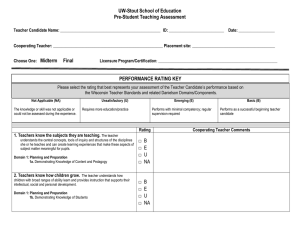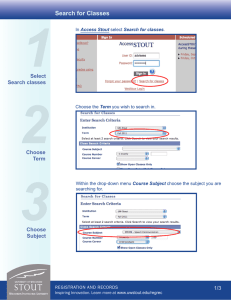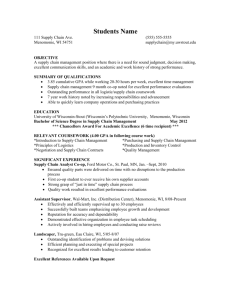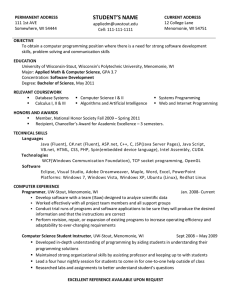UW-Stout School of Education Student Teaching/Internship Assessment Teacher Candidate Name:
advertisement
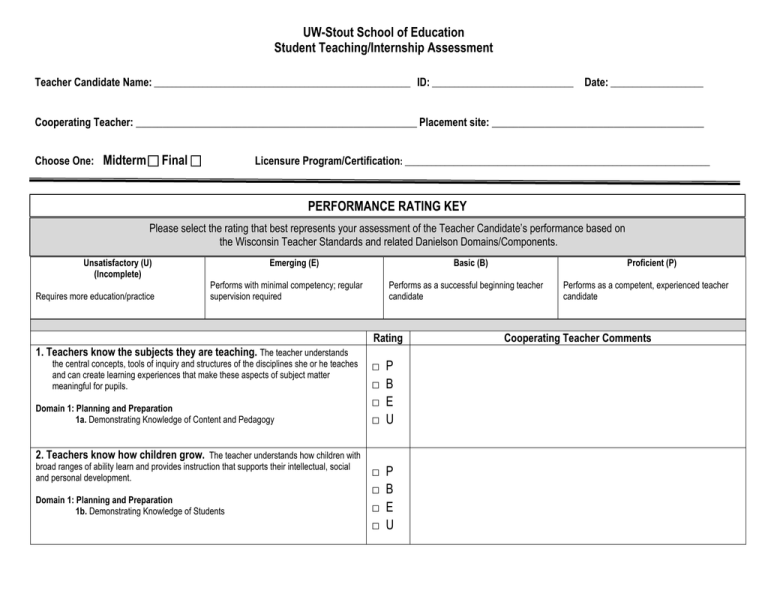
UW-Stout School of Education Student Teaching/Internship Assessment Teacher Candidate Name: __________________________________________________________ ID: ________________________________ Date: _____________________ Cooperating Teacher: _____________________________________________________ Placement site: ________________________________________ Choose One: Midterm Final Licensure Program/Certification: _____________________________________________________________________ PERFORMANCE RATING KEY Please select the rating that best represents your assessment of the Teacher Candidate’s performance based on the Wisconsin Teacher Standards and related Danielson Domains/Components. Unsatisfactory (U) (Incomplete) Requires more education/practice Emerging (E) Basic (B) Performs with minimal competency; regular supervision required Performs as a successful beginning teacher candidate Rating 1. Teachers know the subjects they are teaching. The teacher understands the central concepts, tools of inquiry and structures of the disciplines she or he teaches and can create learning experiences that make these aspects of subject matter meaningful for pupils. Domain 1: Planning and Preparation 1a. Demonstrating Knowledge of Content and Pedagogy 2. Teachers know how children grow. The teacher understands how children with broad ranges of ability learn and provides instruction that supports their intellectual, social and personal development. Domain 1: Planning and Preparation 1b. Demonstrating Knowledge of Students SCHOOL OF EDUCATION Proficient (P) □ □ □ □ P B E U □ □ □ □ P B E U Heritage Hall 267, Menomonie, WI 54751 715-232-1088 Inspiring Innovation. Learn more at www.uwstout.edu/soe Performs as a competent, experienced teacher candidate Cooperating Teacher Comments 3. Teachers understand that children learn differently. The teacher understands how pupils differ in their approaches to learning and barriers that impede learning and can adapt instruction to meet the diverse needs of pupils, including those with disabilities and exceptionalities. Domain 2: The Learning Environment 2b. Establishing a Culture for Learning Domain 3: Professional Practice 3e. Demonstrating Flexibility and Responsiveness □ □ □ □ P B E U □ □ □ □ P B E U □ □ □ □ P B E U □ □ □ □ P B E U 4. Teachers know how to teach. The teacher understands and uses a variety of instructional strategies, including the use of technology, to encourage children’s development of critical thinking, problem solving, and performance skills. Domain 3: Professional Practice 3b. Using Questioning and Discussion Techniques 3c. Engaging Students in Learning 5. Teachers know how to manage a classroom. The teacher uses an understanding of individual and group motivation and behavior to create a learning environment that encourages positive social interaction, active engagement in Learning and self-motivation. Domain 2: The Learning Environment 2a. Creating an Environment of Respect and Rapport 2c. Managing Classroom Procedures 2d. Managing Student Behavior 2e. Organizing Physical Space 6. Teachers communicate well. The teacher uses effective verbal and nonverbal communication techniques as well as instructional media and technology to foster active inquiry, collaboration and supportive interaction in the classroom. Domain 3: Professional Practice 3a. Communicating Clearly and Accurately Domain 4: Professional Responsibilities 4c. Communicating with Families SCHOOL OF EDUCATION Heritage Hall 267, Menomonie, WI 54751 715-232-1088 Inspiring Innovation. Learn more at www.uwstout.edu/soe 7. Teachers are able to plan different kinds of lessons. The teacher organizes and plans systematic instruction based upon knowledge of subject matter, pupils, and the community and curriculum goals. Domain 1: Planning and Preparation 1c. Selecting Instructional Goals 1d. Demonstrating Knowledge of Resources 1e. Designing Coherent Instruction □ □ □ □ P B E U □ □ □ □ P B E U □ □ □ □ P B E U □ □ □ □ P B E U 8. Teachers know how to test for student progress. The teacher understands and uses formal and informal assessment strategies to evaluate and ensure the continuous intellectual, social and physical development of the pupil. Domain 1: Planning and Preparation 1f. Assessing Student Learning Domain 3: Professional Practice 3d. Providing Feedback to Students Domain 4: Professional Responsibilities 4b. Maintaining Accurate Records 9. Teachers are able to evaluate themselves. The teacher is a reflective practitioner who continually evaluates the effects of his or her choices and actions on pupils, parents, professionals in the learning community and others and who actively seeks out opportunities to grow professionally. Domain 4: Professional Responsibilities 4a. Reflecting on Teaching 4e. Growing and Developing Professionally 4f. Showing Professionalism 10. Teachers are connected with other teachers and the community. The teacher engages in relationships with school colleagues, parents and agencies in the larger community to support pupil learning and well-being and acts with integrity, fairness and in an ethical manner. Domain 4: Professional Responsibilities 4a. Contributing to the School and District* *Teacher candidate participates as appropriate* SCHOOL OF EDUCATION Heritage Hall 267, Menomonie, WI 54751 715-232-1088 Inspiring Innovation. Learn more at www.uwstout.edu/soe 11. Teachers use their knowledge of subject matter, teaching and learning, and technology to design, develop, and evaluate authentic learning experiences and assessments using contemporary tools that advance student learning (ISTE Standard 1 and 2). International Society for Technology in Education (ISTE) Standards #1 Teachers use their knowledge of subject matter, teaching and learning, and technology to facilitate experiences that advance student learning, creativity, and innovation in both face-to-face and virtual environments. □ □ □ □ P B E U □ □ □ □ P B E U #2 Teachers design, develop, and evaluate authentic learning experiences and assessments incorporating contemporary tools and resources to maximize content learning in context and to develop the knowledge, skills, and attitudes identified in the ISTE Standards for Students. 12. Teachers demonstrate the effective use of digital tools and resources in a legal and ethical manner to fulfill professional responsibilities (ISTE Standard 3, 4, and 5). International Society for Technology in Education (ISTE) Standards #3 Teachers exhibit knowledge, skills, and work processes representative of an innovative professional in global and digital society. #4 Teachers understand local and global societal issues and responsibilities in an evolving digital culture and exhibit legal and ethical behavior in their professional practices. #5 Teachers continuously improve their professional practice, model lifelong learning, and exhibit leadership in their school and professional community by promoting and demonstrating the effective use of digital tools and resources. COMMENTS: _______________________________________________________________ Student Signature Date ________________________________________________________________ Cooperating Teacher Signature Date ________________________________________________________________ University Supervisor Signature Date SCHOOL OF EDUCATION Heritage Hall 267, Menomonie, WI 54751 715-232-1088 Document revised: December 11th, 2015 Inspiring Innovation. Learn more at www.uwstout.edu/soe
